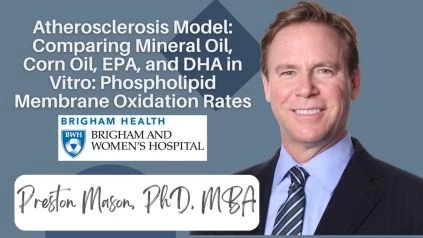Atherosclerosis Model: Comparing Mineral Oil, Corn Oil, EPA, and DHA in Vitro: Phospholipid Membrane Oxidation Rates ...
Preston Mason, PhD, MBA discusses Atherosclerosis Model: Comparing Mineral Oil, Corn Oil, EPA, and DHA in Vitro: Phospholipid Membrane Oxidation Rates
Atherosclerosis Model: Comparing Mineral Oil, Corn Oil, EPA, and DHA in Vitro: Phospholipid Membrane Oxidation Rates Preston Mason PhD
By Preston Mason, PhD, MBA
I'd like to discuss with you two presentations I recently gave at the American College of Cardiology meetings in New Orleans. They both have a similar theme and they both looked at the effects of pharmaceutical grade, mineral oil, and corn. And compared to Eicosapentaenoic Acid and Docosahexaenoic Acid in lipoproteins as well as in membranes. Now, omega-3 fatty acids are, the two primary ones are Eicosapentaenoic Acid or EPA and Docosahexaenoic Acid, or DHA. In clinical trials there have been discordant outcomes depending on the formulation used in trials using a highly purified formulation of EPA, known as icosapent ethyl. There have been significant reductions in cardiovascular events, most notably the REDUCE-IT trial. This was a trial using patients followed over time, and there was a resulting 25% relative risk reduction among patients randomized to icosapent ethyl, or IPE compared to placebo, and this includes a 31% reduction in myocardial infarction, stroke, and cardiovascular death. By contrast trials using mixed omega-3 fatty acids. That is EPA plus DHA. Have failed to show benefit in a consistent basis.
Most notably, or most recently was a STRENGTH trial, which used a identical dose, 4 grams per day of, in this case, a combination of EPA and DHA, like REDUCE-IT there were high risk patients and like REDUCE-IT they looked at a composite of cardiovascular events, but unlike REDUCE-IT, the trial was stopped early due to futility. So there have been a lot of questions about why such different outcomes in these two trials. Well, the obvious point is that these are two different medications. One is a highly purified EPA in the form of icosapent ethyl. The other was a mixed omega-3 fatty acid in the form of free carboxylic acids. And yet still people have asked other questions, well maybe it could be due to the different placebo. One was a mineral oil, which is commonly used in trials involving omega-3 fatty acids, the other was corn oil. Now corn oil is highly enriched with linoleic acid, which is an Omega-6 fatty acid, whereas mineral oil is made up of mixture of aliphatic chains, generally C16 to C24, and they're used again at relatively low doses, 2 grams, BID. Now in this study, we wanted to evaluate what potential effects of these different oils might have on a key pathway of atherosclerosis, namely lipoprotein and membrane oxidation. So when lipoproteins become oxidized, they undergo, they become highly atherogenic. They trigger inflammation, endothelial dysfunction, foam cell formation, and a number of other important pathways leading to atherosclerosis. Now when membranes become oxidized, there's also significant damage to the cell, leading ultimately to cell death by apoptosis or necrosis. It also triggers inflammation, damages proteins leading to alterations of signal transduction, and a number of other changes associated with atherosclerosis. So agents that interfere with lipoprotein and membrane oxidation would be considered atheroprotective.
Now we, in this study, compared these oils on this process now we found very consistent results in these two different lipid fraction. We found that both the pharmaceutical grade mineral oil and corn oil failed to have any effect pro or antioxidant in both the membranes and in the lipoprotein particles. So even at very high doses, even higher than would be seen in clinical trials, these placebo oils had a neutral effect on atherosclerosis. Now by contrast, EPA had very potent antioxidant or AFA protective effects. It inhibited oxidation of both lipoproteins, and this included two different fractions, small dense LDL as well as VLDL and membranes in a highly consistent and reproducible fashion, inhibiting oxidation by as much as 90% up to 4 hours. By contrast, DHA had only limited antioxidant effects that were lost after just a few hours.
So in conclusion, we see very different effects of these different oils on this process of atherosclerosis. Specifically, EPA had potent and reproducible antioxidant effects, which be seen as atheroprotective, that were sustained over time compared to DHA and these two different placebo oils. We also believe that this atheroprotective benefit or antioxidant benefit may be part of the explanation for why formulations using EPA alone may result in the benefits seen in outcome trials compared to mixture of EPA with DHA. I'd like to acknowledge again my co-authors and, this was independently funded study. Thank you very much.
What is Atherosclerosis Model, and how is it used in Cardiology?
Atherosclerosis is a medical condition in which plaques build up inside the arteries, leading to a narrowing of the arteries and reduced blood flow. The development of atherosclerosis is a complex process that involves multiple factors, including inflammation, oxidative stress, and lipid metabolism.
The atherosclerosis model is a way of understanding how this disease progresses and how it can be treated. In this model, the development of atherosclerosis is divided into several stages:
-
Endothelial dysfunction: The inner lining of the arteries (endothelium) becomes damaged, often due to factors like high blood pressure, smoking, or high cholesterol.
-
Fatty streaks: Fatty deposits (lipids) begin to accumulate in the damaged area of the artery, leading to the formation of a fatty streak.
-
Fibrous plaque: The fatty streak can become more advanced and develop into a fibrous plaque, which contains smooth muscle cells, collagen, and other substances.
-
Complicated plaque: In some cases, the fibrous plaque can rupture, leading to the formation of a blood clot that can block the artery and cause a heart attack or stroke.
Understanding the atherosclerosis model is important in cardiology because it helps doctors to identify patients who are at risk of developing the disease and to develop appropriate treatment plans. Treatment options for atherosclerosis include lifestyle changes (such as exercise and a healthy diet), medication to control risk factors like high blood pressure and cholesterol, and in some cases, surgery to open blocked arteries.
10 Key Takeaways from these Clinical trials about the Atherosclerosis Model
-
Omega-3 fatty acids have a protective effect against oxidative stress-induced damage to cell membranes.
-
Pharmaceutical grade mineral oil and corn oil do not provide any significant protective effect against oxidative stress-induced damage to cell membranes.
-
The results of this trial suggest that omega-3 fatty acids may play an important role in maintaining the integrity of cell membranes.
-
The protective effect of omega-3 fatty acids on cell membranes may contribute to their beneficial effects on cardiovascular health.
-
The trial provides further evidence for the importance of a diet that includes a sufficient amount of omega-3 fatty acids.
-
The results of this trial support previous studies that have demonstrated the beneficial effects of omega-3 fatty acids on cardiovascular health.
-
The study suggests that the protective effect of omega-3 fatty acids on cell membranes may be due to their ability to reduce oxidative stress.
-
The trial highlights the potential limitations of using mineral oil and corn oil as control substances in studies examining the effects of dietary interventions.
-
The results of this trial may have implications for the development of novel therapies for cardiovascular diseases.
-
The study provides valuable insights into the mechanisms underlying the protective effects of omega-3 fatty acids on cardiovascular health.
R. Preston Mason, PhD, MBA - About The Author, Credentials, and Affiliations
R. Preston Mason, PhD, MBA, is a renowned scientist and entrepreneur who has made significant contributions to the fields of biochemistry, cardiovascular disease, and translational medicine. He is currently an Associate Professor of Medicine at Harvard Medical School, where he leads a research laboratory focused on developing novel therapeutic approaches for cardiovascular disease.
Dr. Mason earned his Bachelor of Science degree in chemistry from Tuskegee University, followed by a PhD in biochemistry from Emory University. He then pursued an MBA from the Wharton School at the University of Pennsylvania, where he developed his business acumen and honed his skills as an entrepreneur.
Throughout his career, Dr. Mason has held various academic and industry positions, including serving as a faculty member at the University of Connecticut School of Pharmacy and as a senior scientist at Pfizer, Inc. He has also founded several companies, including Elucida Research, LLC, which develops drug delivery technologies for various therapeutic applications.
Dr. Mason's research has led to over 150 peer-reviewed publications and numerous patents. His work has been recognized with several awards, including the American Chemical Society's Heroes of Chemistry Award and the Black Engineer of the Year Award. He is also a Fellow of the American Heart Association.
In addition to his research and entrepreneurial pursuits, Dr. Mason is dedicated to mentoring the next generation of scientists and entrepreneurs. He has served as a mentor to numerous graduate students, postdoctoral fellows, and young professionals, and he is committed to promoting diversity and inclusion in science and entrepreneurship.
Overall, Dr. R. Preston Mason's interdisciplinary background and expertise have enabled him to make significant contributions to the fields of biochemistry and cardiovascular disease, while also serving as a role model and mentor for future generations of scientists and entrepreneurs.




